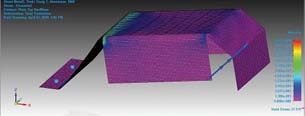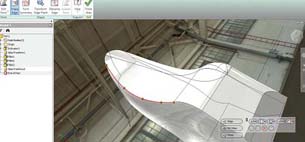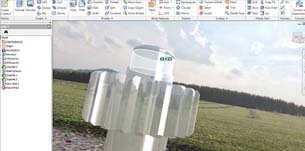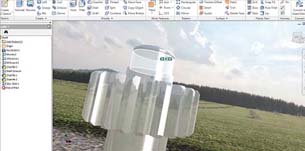Heavy Metal, Light Metal: Solid Edge with Synchronous Technology 2
Solid Edge with ST2 offers sheet metal options, cloud computing's effect on resellers, Alias tackles curves, and Autodesk Vault renews data management.
June 1, 2010
By Kenneth Wong
 With Solid Edge with Synchronous Technology 2, you can analyze a sheet-metal part as a composite of 2D mid-planes. |
Sheet metal work is quite unlike traditional part modeling. Instead of features and blocks, you work mostly with plates, flanges, and tabs. Compared to part modeling, sheet-metal workflow is much more predictable. You spend a lot of time drawing rectangles and turning them into tabs; you repeatedly select edges to add flanges.
In 2008, when Solid Edge with Synchronous Technology (SE with ST) made its debut, it did so with one glaring omission: no dedicated sheet-metal operations. The second release of SE with ST fixed that. But sheet metal modeling in SE with ST2 is not simply a standard set of menu items. I find that SE with ST2 anticipates many of the steps in the standard workflow.
If I sketch a rectangle on the surface of an existing plate, the software deduces (correctly) that I want to turn that into a tab with the same thickness, to be connected to theexisting plate. So once I click on the extrusion handle, it automatically converts the sketch into a tab.
After selecting an edge, I don’t need to bother telling SE with ST2 I want to create a flange. I can simply drag the extrusion handle to create the flange. In fact, I don’t even need to specify the direction of the flange.
The direction to which I drag the handle sets the direction of my flange. Along the way, whenever I pick a menu item, a floating toolbar appears to let me customize the operations (bend radius, offset distance, whether to create the bend from outside surface or inside, and so on).
With history-based modelers, the user has a tendency to create sketches or features in precision from the beginning. For instance, if you’re about to create a tab, you begin by drawing a rectangle with the exact width you want, positioned at a precise distance from an outer edge. You could, of course, still do that in SE with ST2, but I find that I can forgo such rigid ways of working.
Taking advantage of the ease with which I can modify dimensions and parameters (and doing so without worrying about regeneration failure), I might just draw a rough profile for a tab, place it at random on a surface, then adjust its size and position after the fact.
Quite often, sheet metal parts are analyzed not as solids but as a collection of 2D surfaces. With SE with ST2, I can use the mid-plane surface creation command and dialog box to automatically turn a 3D sheet metal piece into 2D planes. Other commands—for creating contour flanges, punching dimples, and closing two bended corners—make sheet metal creation in SE with ST2 much easier. For a video demonstration of the features discussed here, visit: deexchange.ning.com.
Cloud Computing Shadow over Resellers
Traditionally, professional software publishers like Autodesk, Dassault, PTC, and Siemens distribute their CAD and PLM (product lifecycle management) software suites through resellers. They’re not just there to take your purchase orders and process them. They often bundle the transaction with consultation, services, training, technical support, and other complementary offerings. Hence, the term Value-Added Resellers (VARs).
 Allan Behrens, an analyst from Taxal, led a discussion on the fate of resellers in the dawn of cloud computing. |
What’s to become of these resellers when cloud computing gains mass adoption? Would breaking up current software packages into a bunch of browser-accessible services make resellers unnecessary? What values can they offer if vendors choose to transform complicated modeling packages into simpler modules, delivered over the web? These questions—and many more— force resellers to scan the horizon in search of cloud computing’s silver lining.
At the Congress on the Future of Engineering Software (COFES) 2010, Allan Behrens, an analyst from Taxal, led a discussion on this topic. The following is a sampling of the conversation that took place:
Martyn Day (DEVELOP3D): This is the worst recession I’ve ever seen. Yet, only a couple of dealers have gone bust. That’s amazing. In the previous ]recession], dealers were against the wall. They were lucky if they’ve got three months’ cash. Now, this is the worst time, yet no large dealers have gone bust, because they’re guaranteed the subscription revenues; they’re selling it forward.…
Unknown: The other side of the issue is, can a vendor afford to not have a ]reseller] channel? They’ve all tried direct sales before; they haven’t been successful. Is being in the cloud going to change that?
Behrens: The thing about the cloud is, if you don’t have a channel for products that are sub-$5,000, who’s gonna sell to the customers? Customers still need to be sold. They don’t buy products, unless they’re sold to. You still need face-to-face, desk-to-desk sales from people …
Unknown: Are you describing a PLM system that’s more like Salesforce.com?
Behrens: Well, I’m trying not to describe anything, because I don’t think any of us know actually what the outcome will be. But there are solutions that are out there, being prototyped by SolidWorks … and Autodesk … And there are PLM solutions that are practically made available over the web. I don’t think we know yet, but we make the assumption — certainly, I made the assumption — that it will happen, because the cost-benefit ]ratio] of going to a thin client or some sort of thin platform at the office is there, so it’s going to happen one day. The challenge is, how soon, how will it be delivered, how will it be serviced?
 Alias Design for Inventor, a plug-in that comes with Alias Design 2011, lets you apply NURBS editing to your Inventor model. |
Martyn Day: But that means more component-alization of software …
Ping Fu: I do believe the change is pretty sweeping … we all love Apple apps, not just because they’re cheap, but because they’re so easy to use. … How many things we offer today in our software could be broken down ]into] little apps?
Arnold van der Weide (Open Design Alliance): The trick of being a reseller is, you need to add value. In the past, it was delivering a CD. In the future, it might be breaking ]the software] up into apps …
Ping Fu: With this new way of ]delivering software], we could actually do it smarter. Instead of customizing ]the software] for each industry, we could have apps for different industries that run on the same complex, powerful code.
Behrens: Is that going to happen with an established player, or is that coming from a start-up business? Is that a new company coming out of the left field?
Unknown: My prediction is, it’s going to be a new player. You’ve got these ships— the channels, R&D, everything, this is the way they do it. To change direction, it’s going to take somebody new with a different idea.…
What do you think will happen to reseller channels when cloud computing goes mainstream? Share your thoughts by leaving a comment for the original blog post.
Alias for Inventor 2011: Curves Ahead!
Curves, curves, curves—from the mouse in your grip to the furniture you’re sitting on, pretty much everything is made up of them. Generally speaking, complex shapes and surfaces made of rolling, sweeping curves aren’t the forte of mechanical CAD programs. That’s the reason some designers routinely turn to a NURBS-modeler like Rhino to sculpt out the shape they want, then export it back into their favorite CAD programs.
Alias Design 2011 is Autodesk’s headlong charge against the Rhino herd. Along with the software comes a plug-in, dubbed Alias Design for Inventor. Upon installing Alias Design, the Alias plug-in gets installed in your copy of Inventor (of course, you must already have Inventor installed in your machine).
This gives you access to Alias-style NURBS-editing tools, right from within Inventor. You can now select the edges on your model and deform them by pushing and pulling on control points. This method allows you to create the type of free-flowing shapes that don’t come easily in mechanical CAD programs.
 With reflections, ground shadows, and environment maps turned on, you can work in a fully rendered, interactive environment in Inventor 2011. |
The Alias tab also gives you the Symmetry command, which functions like a Mirror command that remains active throughout your modeling session. You invoke the command, specify the imaginary center plane, and then you go to work. As you do, the deformations and edits you make on one side are automatically replicated on the opposite side. This makes it easy to create complex features with uniformity on both sides. If satisfied, you can move right back into Inventor modeling mode to continue working with traditional mechanical tools.
Autodesk Inventor 2011 remains a parametric modeler, but many operations— such as extrusions, rounds, and holes—can easily be adjusted by push-pull methods, as you might in direct modeling programs like SpaceClaim or CoCreate. (Inventor Fusion, currently available as a free technology preview from Autodesk Labs, may offer clues on how Inventor will look in the future.)
The visual display in Inventor 2011 is much more robust than in previous versions. Along with the usual wireframe, rendered, and shaded modes, you can now apply the watercolor mode too. In addition, you can turn on environment maps and reflections. This lets you work in, for example, the 360-degree environment of a used warehouse or a lab (to name but two preloaded environments).
This means interacting with your model in a fully rendered environment, with ground plane shadows and all. In fact, if you assign a highly reflective material to your design (such as polished steel), you can zoom in close to see the roof of the warehouse reflected on its faces.
But harnessing all these display settings also means putting a heavy burden on your CPU, so you should strike a balance between what you need to do and your preferred visual setup. If all you’re doing is adjusting the radius of a steering wheel, why bother with reflections? On the other hand, if you’re designing a chrome part that’s meant to sit on the hood of an all-terrain vehicle, maybe you do want to turn on reflections to see whether it’ll be a distraction to the driver or an aesthetic compliment to the overall design.
Alias Design gives you surfaces with G2 continuity, constructed to ensure smoothness and curvature consistency. The tools in the Inspect tab in Inventor enable you to check the quality of your geometry by applying zebra stripes and colored contour lines.
Several years ago, anticipating the incorporation of Autodesk media and entertainment division’s technologies into manufacturing products, the company’s senior VP of manufacturing solutions, Buzz Kross, cheekily remarked on the arrival of “the pony-tailed crowd.” With Alias Design for Inventor, you may actually get to design something with swirls and curves that mimic a ponytail.
Listed price for Alias Design 2011 is $4,590 with subscription or $3,995 without subscription. In addition to Alias Design, Autodesk also offers Alias Surface and Alias Automotive, two higher end versions. For a video demonstration of the features discussed here, go to: deexchange.com.
Vault 2011: Data Management Has a New Face
Brian Roepke, Autodesk’s senior product manager for the Vault product line, believes he can make data management “sexy” (his word, during a briefing with industry reporters and bloggers in April, 2010). In Autodesk Vault 2011, data management gets a new face. It isn’t exactly the face of a supermodel, but it’s a model—your 3D CAD model. Gone is the usual, uninspiring Excel-like interface so common among data management systems. With Autodesk Vault 2011, Workgroup Edition, your Inventor 3D model is your data management interface.
 In Autodesk Vault 2011’s visual environment, you may isolate certain subassemblies and parts to probe further or perform edits. |
Suppose you need to get a snapshot of your project, to scan the parts that are released to production, those that are behind deadline, and those that are in revision. You won’t need to squint at a series of columns and cells populated with check marks and dates to get the information. Instead, you can launch your 3D assembly and get the status reports, right from within Autodesk Inventor. Your model will become a colorcoded assembly, with all the revisions, released parts, and delayed parts highlighted in different shades. You’ll still get pie charts, but they now work as legends that tell you what each color represents.
Dassault, makers of SolidWorks and a competitor to Autodesk in mid-range CAD, also advocates the use of a 3D assembly to inspect and view product lifecycle management (PLM) repositories. It calls its solution 3DLive Product Information. Late last year, Siemens PLM Software took a similar approach with NX with HD3D, described as “a simple and intuitive way to collect, collate, and present information” (see “NX7 with HD3D: Where CAD Geometry and Lifecycle Mingle,” Virtual Desktop blog, November 4, 2009). However, Roepke pointed out Autodesk Vault’s visual data-management environment had been in development for roughly 18 months, so it wasn’t a reaction to Siemens’ HD3D.
The visual environment is driven by meta data you maintain using Inventor and Vault (part numbers, suppliers, check-in, checkout, and so on). The new approach may yield insights into your project that weren’t easy to obtain before. For instance, by displaying parts that are delayed or overdue by geographical distribution, you may be able to detect certain bottlenecks and hiccups in your supply chain or subcontractors who are under-performing.
According to Roepke, Autodesk Vault Workgroup (despite its name) may be used as an enterprise-class PDM platform. Basic Autodesk Vault comes free of charge with purchase of most major Autodesk products (such as Autodesk Inventor), but upgrade to more robust editions requires a fee.
More Info:
Autodesk, Inc.
Kenneth Wong writes about technology, its innovative use, and its implications. One of DE’s MCAD/ PLM experts, he has written for numerous technology magazines and writes DE’s Virtual Desktop blog at deskeng.com/virtual_desktop/.
Subscribe to our FREE magazine, FREE email newsletters or both!
About the Author
Kenneth Wong is Digital Engineering’s resident blogger and senior editor. Email him at [email protected] or share your thoughts on this article at digitaleng.news/facebook.
Follow DE





